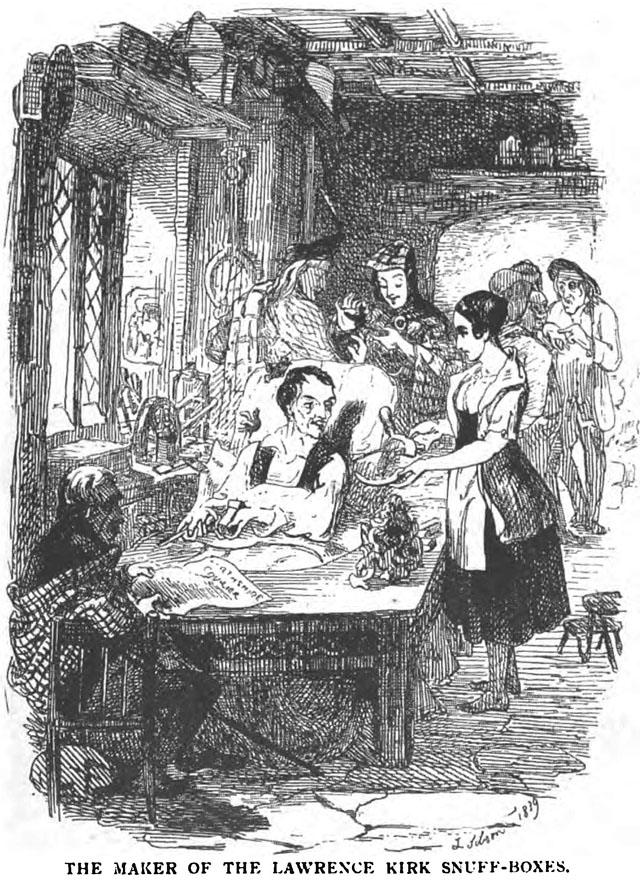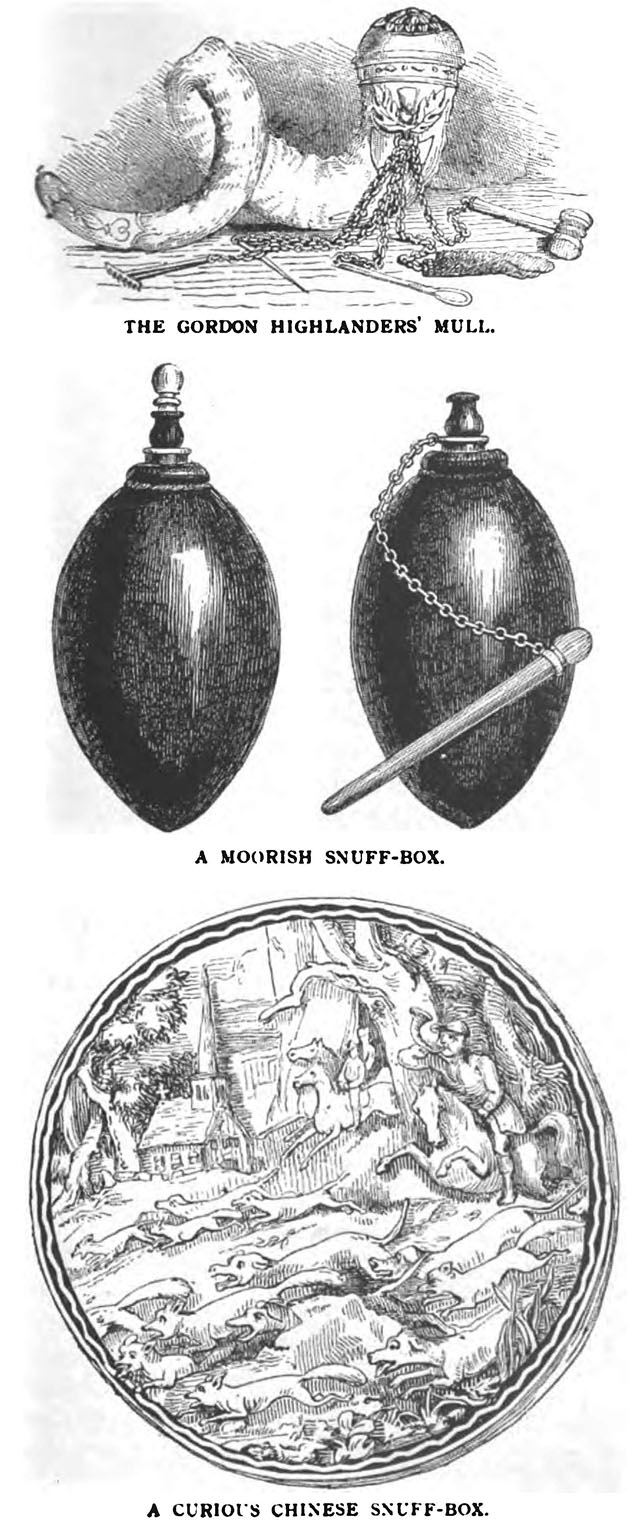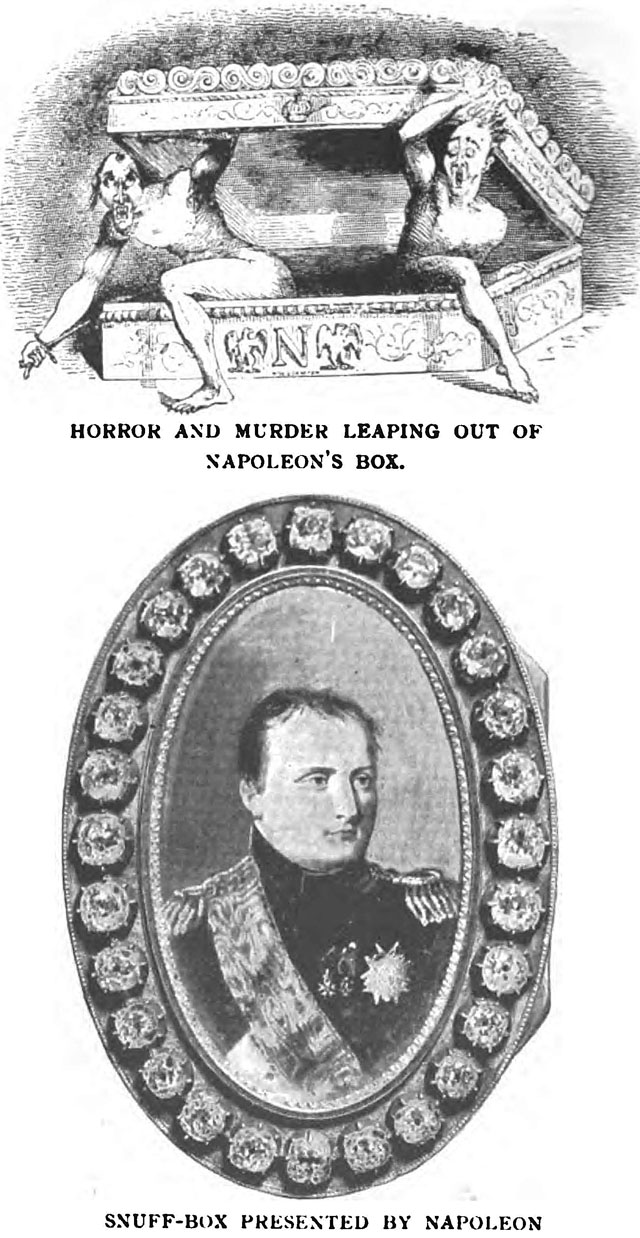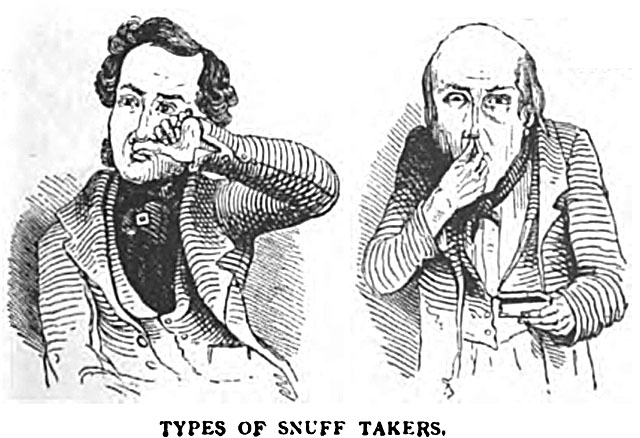quote:
Snuff-boxes were often made out of relics possessing historical associations, such as Shakespeare's mulberry tree, the hull of the Royal George-in which "brave Kempenfeldt went down, with twice four hundred men " - or the deck of the Victory on which Nelson died for "England, home, and beauty." Sir Henry Irving is the proud possessor of one of the mulberry-tree boxes which belonged to David Garrick, who cut the wood of which it is made. Our leading actor also has Macready's silver box, and a third decorated with a medallion hearing the bust and name of John Philip Kemble.A story is told of a party of gentlemen who were comparing their snuffboxes. One was made from a leaf of the table on which Wellington wrote the Waterloo dispatch; another from Canova's footstool; a third from the rockers of Harry Bishop's cradle; a fourth from the sign of "The Bear," Devizes, beneath which Sir Thomas Lawrence began to paint; Crabbe's cudgel; and Siddons's desk. All these, a melancholy individual who had joined the company said he could eclipse with a collection of boxes of far greater interest and value. Among those he mentioned was one made out of the flooring of the garret where that remarkable idiot, Smith, was confined; another out of the door of Mrs. Brownrigg's coal-hole, in which she hid the 'prentices, she beat to death. But the one he was most proud of was a box made out of a bit of plank from the Red Barn, with Corder's shots and his victim's blood distinctly visible! An incredulous exaggerator, however, trumped all these wonders by boasting that he himself possessed a box, "certainly somewhat worm?eaten," which was turned from a section of the tiller of Noah's ark!
Our next illustration introduces us to the strange character who made the famous "Lawrence Kirk" snuff-boxes. Lameness compelled him to keep his bed; but round it a platform was fixed on which the poor fellow worked, turning out the beautifully finished little boxes, which were so justly famed, and constructing a host of ingenious instruments and mechanical contrivances. He was very fond of birds; and his cheerful nature caused his home to be the gossipshop of the neighbourhood.

The favourite receptacle with Scotchmen for their cherished snuff is the mull -made of the small end of a horn. Some are enriched with brilliant cairngorms and other stones, and have attached to them a variety of little implements of silver to assist the snufftaker in the most luxurious style. A little woodcut shows a very splendid specimen:......one of a pair owned by the gallant Gordon Highlanders. There is a hammer to tap the side of the mull, should the snuff adhere; a bodkin to pierce and separate it; a rake to collect the snuff into the little spoon or shovel; and a hare's foot to brush loose particles from the nose or lip.
We also give old woodcuts of two other highly curious boxes. One is a Moorish specimen, made of ebony, and has attached to it, by a silver chain, an ivory stirrer which also serves as a stopper. The other, made of tortoiseshell, gives a Chinaman's quaint idea of an English fox-hunt.
Many ofthe magnificent boxes of the old snufftaking days have been carefully preserved. Some, rich in historical association, have been treasured and handed down from generation to generation. Others again are of such exquisite beauty and workmanship, often enriched with magnificent diamonds of the tinest water, cameos of the most delicate design, or the no less valuable minatures, that their mere intrinisic worth, apart from their value as works of art, quite warrant the jealous care with which they are guarded.
A large number were lent by their owners to the Stuart Exhibition. One, made of silver, belonged to the Marquisof Montrose; and it is said that it was the last thing he held in his hand, before mounting the gallows. Another, of oak from the Boscobel Tree, is mounted in silver with a representation of Charles II. hiding in the oak, and the party of soldiers searching for him. The boxes given by the Young Pretender to some of his followers also attracted much attention, as well as those decorated with his portrait. In one box, the latter is hidden behind a movable mask; and, in another, in an under-lid. Here, too, was to be seen a silver snuff-box which belonged to the Prince's devoted adherents the brave and daring Flora Macdonald and her husband.

The Guelph Exhibition also included a large number of interesting and beautiful boxes. Several contained some of Cosway's exquisite little miniatures. Here was to be seen the gold box given by Byron to Edmund Kean, and Garrick's favourite box, with a portrait of his brother Peter. Another example much noticed was one with a painting of the "Hell Fire Club," Which existed in Dublin before the Union, and embraced in its membership several notabilities of the day. The club held its orgies at a house on the hill above Rathfernham, in imitation of a similar institution in England called "The Monks of Medmenham Abbey," of which Wilkes was a member. Several royal snuff-boxes graced the exhibition. One, presented by Princess Amelia, daughter of George III., to the Hon. General Fitzroy, contained a lock of her hair. Three or four others were owned by George IV., including the one he gave to Sir Walter Scott. Another curious specimen, made of bloodstone, lent by the Duke of Cambridge, had a dog on the cover with eyes and teeth of diamonds and a cornelian tongue.
Talking of royal boxes recalls a tale told of Frederick of Prussia who was an inveterate snuff-taker. There seems to have been some bad feeling between him and Count Schwerin. At all events, his Majesty presented the Count with a snuff-box, on the inside of which was painted a donkey's head. Next day the Count produced the box at dinner and showed it to the Duchess of Brunswick. "What an excellent portrait of His Majesty! " remarked the Duchess. The King look somewhat annoyed. "Is it not a fine portrait?" said the lady, handing it to her neighbour. "Most excellent," was the reply; and the box began to travel round the table, when the King ordered it to be handed to him. His feeling can be imagined, when he found that the wily Count had had the donkey's head removed and a portrait of himself substituted, in order that he might teach the King a lesson.
The Jones Collection, at the Albert and Victoria Museum, is peculiarly rich in snuff-boxes, of rare beauty and value. One alone, painted by Blaremberghe, has been valued at £1,500, and many others are worth nearly as much. Several of the miniatures inserted in the lids are by Petitot. One box, which was formerly in the possession of Demidoff, has miniatures of Marie Antoinette and the whole family of Louis XVI. Near by is the gold-mounted snuff-box of Sir Thomas Lawrence, made from the cinder or lava of Vesuvius. A fantastic specimen is one made of amethyst, representing a lamb lying down. The ears are of ruby, and the eyes, being of diamonds, seem positively to flash fire. Among the tortoise- shell boxes, is one said to have been given to Marshal Vauban by Louis XIV. ; and another, supposed to have belonged to the ill-fated Marie Antoinette, was presented to the family of the donor by Prince de Conde. At the British Museum, the collection of snuff-boxes, though not large, is of a highly interesting character. In the Asiatic Saloon are a number of the quaint little porcelain bottles in which the Chinese kept their snuff. Some have tiny spoons attached to the stoppers, a few of which are enriched with precious stones. The designs and colour are most varied; no two are alike. There is one beautiful little specimen of the rare Sang de Bauf-the brilliant red glaze the secret of which was never divulged by its maker, at whose death, in 1610, it was lost. A charming little col1ection of Chinese snuff-bottles, in glass, will be found in the Glass Room. It includes some nice specimens of slip decoration, some clever imitations of onyx, chalcedony, turquoise, &c., and a pretty little box richly studded with fine imitation gems. In the Mediaeval Room, are a number of curious old pressed horn and tortoise-shell boxes decorated, in relief, with busts of various monarchs, classical and other subjects.
A few of the choicest specimens will be found in the Gold Ornament Room. Lying by the side of his watch is to be seen the gold snuff-box of Gibbon. It is said that whenever the historian was going to say a good thing he announced it by a complacent tap on his box. Here, too, is an enameled gold snuff-box in which Queen Charlotte kept her dearly loved mixture of Spanish or Violet Strasburg, to which her Majesty always added a little green tea. Another box which is sure to attract attention is one made of Lumachelli, or "fire marble," with its fascinating play of colours. The lid, and those of two or three other boxes, are enriched with lovely cameos.

The two Napoleon snuff-boxes are especial favourites with the public. One was presented to the Hon. Mrs. Damer by the Emperor, in acknowledgment of a bust of Charles James Fox, which the lady had chiseled for him with her own fair hands. A miniature of Napoleon which adorns the lid is encircled with magnificent diamonds.
The second box, which had been presented to the Emperor by Pope Pius VI., at Tolentino, has the lid set with a superb antique cameo. At Napoleon's death, the box was found with a piece of paper inside bearing the following words; "L'empcrcur Napoleon a Lady Holland temoignage de satisfaction et d'estime." Lord Carlisle, when he heard of the legacy, with very bad taste, gave vent to his feeling against the dead emperor in some lines commencing, "Lady, reject the gift, 'tis tinged with gore!" The verses greatly amused Byron, who thus parodied the first stanza ;-
Lady, accept the box a hero wore,
In spite of all this elegiac stuff :
Let not seven stanzas written by a bore,
Prevent your Ladyship from taking snuff!
Lord Carlisle's suggestion that Horror and Murder would leap out every time the box was opened, is also caricatured in the little woodcut reproduced; though it is evident that the artist had never seen the gift itself.The snuff-box also elicited other poetical effusions more in keeping with Lady Holland's feelings. One is from Tom Moore ;-
Gift of the Hero; on his dying day
To her, whose pity watch'd for ever nigh.
Oh! cou'd he see the proud, the happy rav,
This relic lights up in her generous eye,
Sighing, he'd feel how easy 'tis to pay
A friendship-all his Kingdom cou'd not buy.
Lady Holland placed great value on this token of the Emperor's grateful remembrance of her kindness to him during his imprisonment at St. Helena. At her death she bequeathed the box to the Museum. 



 SMP Silver Salon Forums
SMP Silver Salon Forums

 General Silver Forum
General Silver Forum

 1903: SNUFF-BOXES AND SNUFF-BOX STORIES
1903: SNUFF-BOXES AND SNUFF-BOX STORIES







